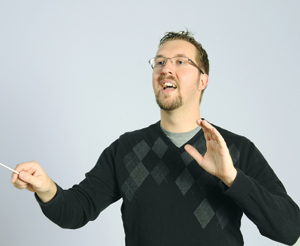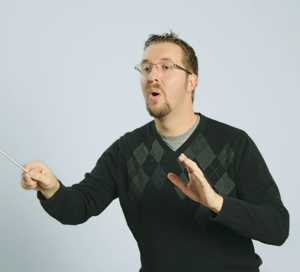Because undergraduate conducting classes have many topics to discuss, too little time is spent on expressive conducting. As a result graduates quickly forget what they have learned and revert to unclear gestures. Many problems bands encounter can be improved with clearer and more expressive gestures.
An Expressive Face
Conductors may find it painful to watch a video of themselves performing because it can reveal many bad habits, including a lack facial expressions. A conductor’s face will often reflect any negative attitudes or emotions. While on the podium, some directors unintentionally show their disapproval or disinterest in the performance. This may influence the behavior of the ensemble members. Instead of making the music enjoyable, they place added stress on the group.
Directors should create a repertoire of facial expressions to draw from while conducting. To practice, make a list of five emotions such as happy, sad, angry, jubilant, and melancholy. Look into the mirror and create a facial expression for each emotion while saying each of the five vowels in the alphabet. With a metronome (tempo 60-72), first practice changing these expressions every four beats, and then vary the amount of time between changes for different beat patterns, including mixed meters. Any vowel can work for any of the emotions, but vary them so each emotion looks a little different every time.
Once comfortable with these expressions, incorporate them into rehearsals and make eye contact with students. Sometimes I make notes in the score to remind myself to look happy. Letter B of the first movement of Holst’s First Suite in E Flat sounds joyful to me, so I might write “happy E” in the score to remind myself to show the happy emotion. This is more to remind myself to vary my facial expressions than to make sure all the students see it. To supplement the faces, I will write three adjectives in my scores for each section of music to get an idea of how it should sound.

Happy A

Happy I

Happy O
Clear Prep Gestures
I have noticed in my early experience and in many young conducting students that the flow of time tends to be uneven in the prep. All too often it consists of a quick motion upward, a short pause, and a fast drop to the downbeat. This jerky motion not only obfuscates the tempo but causes performers to take uneven breaths. The prep and pattern should demonstrate an even flow of time and should provide students with all the necessary information about tempo, style, breath, and dynamics.
The prep gesture should be in the tempo of the piece and occur one beat prior to the attack, so if the sound begins on 1, the prep beat should be on 4. The character of the prep should clearly reflect the character of the music. Marches often require a short, light prep and chorales require a long smooth prep, but default gestures usually meld these two styles together. If the prep for an allegro, forte piece is too large, it will cause heavy playing and a dragging tempo, not to mention tired shoulders. While studying a score, conductors should experiment with different gestures to find what fits. It can even help to practice these in front of an ensemble and ask them what felt most comfortable. Simple gestures communicate the best.
No matter the style or tempo, breathe in a way that matches the prep. It makes little sense to begin rehearsal with breathing exercises and later contradict yourself with a jerky prep and shallow breathing. Shallow breathing or inhaling through the nose makes the players tense. When conductors take shallow or tense breaths, students will mimic the tension and take shallow breaths. Breathing through the nose creates tension in the throat and shoulders and does not allow for adequate air support. To prevent this, encourage and demonstrate breathing through the mouth. For a fast tempo, I would recommend giving two prep beats and breathing over those two counts. At faster speeds, more prep counts make the musicians more comfortable and allow for a deeper breath.

Angry E

Angry I

Angry U
When to Beat Time
Musicians do not need to see every beat, and sometimes a conductor should just stop beating time. If a conductor beats time while the entire ensemble plays a whole note, players will stop their air and decrescendo through the note. Show a crescendo gesture without each individual beat and the ensemble will sustain the air with greater intensity.
I recently worked with a high school program before a festival. While rehearsing the group, I turned to their director and asked if they had written in phrasing for a particular section, to which he said “Yes, but they don’t do it consistently.” I decided to rehearse the section again, but this time I just gave the start and end of the piece. They played together quite well, and for the next run through I simply indicated phrases: a crescendo for two measures, a decrescendo for two measures. Everyone, including the director, was quite pleased. Students don’t need the beat so much as they need a tour guide. Certainly there are works that require more conducting than others, but there is no need to beat time just for the show of it. Focus on what is most important musically.
If a whole note or half note is the only thing in a measure, I would show the sustain by moving the baton straight from left to right, instead of up or down for a crescendo or decrescendo. Directors often tell students not to breathe on the barline, but the fourth beat in the four pattern has a high ictus that encourages a break and a breath. If we show a sustaining motion the ensemble will be more apt to maintain the sound.
Style Matters
Conducting gestures need not be overly dramatic, but they should clearly relate to the style of the music. This requires a diverse vocabulary. A lyrical work with broad phrases calls for a pattern with more horizontal motion and less vertical. Staccato and marcato are similar, but the gestures should have a visible difference. Marcato has a little more length and motion than staccato and is a little heavier. I remember watching a video by Allan McMurray with an exercise for staccato where you poke the baton through a small piece of paper and flick the wrist to get it off. That motion suggests a lighter sound, but if you add more arm and more weight to that motion, it shows an accent for a marcato style.
Make patterns smaller and clearer to help draw the eyes of the performers to adjust the tempo. Most directors use larger and heavier patterns to pull along dragging tempos, but this exacerbates the problem and makes for a tired conductor.
Closing Thoughts
Directors can practice with their ensembles using exercises like this one: ask the ensemble to play constant eighth notes on a given pitch and follow what they see. Conduct a basic, medium-size four pattern. After they become comfortable, change one thing about the pattern – make it staccato, for example. Notice how slowly or quickly the ensemble changes to match what you show. Randomly change other elements, including size, style, tempo, and even meter, but change only one aspect of the pattern at a time. To conclude, slow the ensemble with a ritardando that leads to a fermata on a weak beat, such as beat two of a four pattern. After the exercise, ask the ensemble which gestures were easy to follow and which were unclear. Finally, directors should be willing to seek instruction and continue refining their craft. This can be through attending workships or inviting a guest clinician. All conductors struggle with expressiveness and can benefit from each other.





